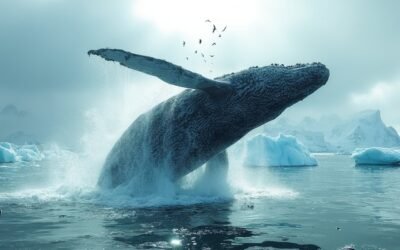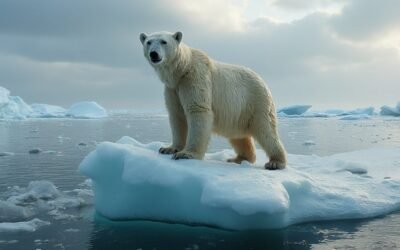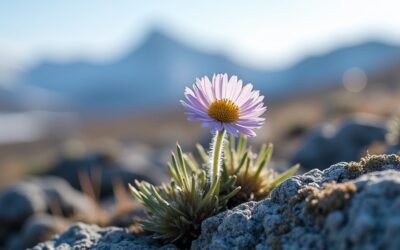Reindeer exhibit various adaptations to thrive in the Arctic climate effectively. Their insulating winter coat, consisting of dense underfur and hollow hairs, provides thermal protection. UV vision adaptation enhances predator detection and navigation in dim light. Efficient heat regulation through specialized muzzles helps conserve energy. Seasonal eye color changes aid vision in varying light conditions. Antlers serve crucial social and survival functions, including mating competitions and food access. Their large, concave hooves facilitate movement and foraging in snow. Finally, adding seaweed to their diet ensures additional caloric intake during food scarcity. Discover more about these fascinating adaptations further.
Main Points
- Reindeers' dense underfur and hollow hairs provide exceptional insulation against the Arctic cold.
- UV vision enhances predator detection and food location, crucial for survival in low-light conditions.
- Large, concave hooves act like snowshoes, aiding in mobility and foraging through deep snow.
- Efficient heat regulation via a heat-exchange system in their muzzles conserves energy in extreme temperatures.
- Seasonal seaweed diet adaptation provides essential calories during harsh winters, showcasing their dietary flexibility.
Insulating Winter Coat
The reindeer's insulating winter coat, comprising a dense underfur and a shaggy outer layer, is essential for its survival in the Arctic's severe cold. This dual-layered fur is a remarkable adaptation that allows the reindeer to withstand some of the harshest conditions on Earth. The dense underfur is ultra-fine and acts as a thermal barrier, trapping heat close to the reindeer's body and minimizing heat loss. This layer is crucial for maintaining core body temperature during the frigid Arctic winter.
Complementing the underfur, the shaggy outer layer consists of hollow hairs that provide additional insulation. These hollow hairs create an extra buffer against the cold, further enhancing the reindeer's ability to brave freezing temperatures. The combination of these two layers forms an efficient insulating winter coat that guarantees the reindeer remains warm and protected from the elements.
UV Vision Adaptation
Reindeer possess a remarkable adaptation that allows them to see ultraviolet light, a pivotal advantage in the Arctic's extreme conditions. This capability, coupled with their eyes' seasonal color change from gold in summer to blue in winter, enhances their ability to detect predators and navigate the snowy terrain. By utilizing ultraviolet light, reindeer can effectively identify important visual cues, ensuring their survival in the harsh Arctic environment.
Seasonal Eye Color Change
How do reindeer's eyes adapt to the extreme conditions of the Arctic, enabling them to switch from gold in summer to blue in winter for enhanced ultraviolet vision? The unique adaptation of reindeers' eyes to the Arctic tundra involves a fascinating seasonal color change. During the summer months, reindeers' eyes are gold, allowing them to efficiently reflect light in the bright conditions of the Arctic. However, as winter approaches and daylight diminishes, their eyes transform to a deep blue hue. This color change plays an essential role in enhancing their vision under low-light conditions and improving their ability to perceive ultraviolet (UV) light.
Here are key points about this remarkable adaptation:
- UV Light Detection: The blue winter eyes of reindeer enable them to see ultraviolet light, which is crucial for detecting food and potential dangers against the snowy landscape.
- Improved Night Vision: The blue coloration helps in maximizing the available light, allowing reindeer to navigate and forage effectively during the long Arctic nights.
- Survival Mechanism: This eye color change is an evolutionary adaptation that enhances survival in the harsh Arctic environment.
- Unique Adaptation: Among mammals, reindeers are unique in possessing this seasonal eye color change, underscoring their specialized adaptation to the Arctic tundra.
Predator Detection Enhancement
Enhanced ultraviolet vision in winter provides reindeer with a critical advantage in detecting predators against the stark, snowy Arctic landscape. This unique adaptation allows reindeer to perceive ultraviolet light, which is invisible to many other animals, including their primary predators. Snow, which reflects ultraviolet light, creates a high-contrast environment where predators such as wolves, which do not have UV vision, are easier to spot.
Reindeer eyes can change color from golden in summer to blue in winter, enhancing their UV light sensitivity. This color change improves their ability to detect subtle differences in the snowy surroundings, aiding in predator detection. The blue coloration increases the scattering of UV light within their eyes, enhancing visual acuity in low-light conditions typical of the Arctic winter.
Additionally, this ultraviolet vision adaptation allows reindeer to navigate the harsh Arctic landscape more effectively. By discerning predators against the white snow, reindeer can react swiftly to potential threats, thereby increasing their chances of survival. This evolutionary trait underscores the remarkable ways in which reindeer have adapted to their challenging environment, highlighting the intricate relationship between physical adaptations and survival strategies in the wild.
Ultraviolet Light Utilization
In the harsh Arctic environment, the ability to utilize ultraviolet light greatly enhances the survival prospects of reindeer. This unique vision adaptation allows reindeer to navigate and thrive in their extreme habitat. Unlike the human eye, which blocks UV light, reindeer eyes are sensitive to this spectrum, enabling them to see in the long, dark winters and snowy landscapes.
Ultraviolet light detection provides several essential advantages for reindeer:
- Enhanced Food Detection: UV vision helps reindeer locate lichen, their primary winter food source, which absorbs UV light and stands out against the snow.
- Improved Predator Awareness: Predators, whose fur often reflects UV light, become more visible to reindeer, aiding in early detection and evasion.
- Seasonal Eye Color Change: Reindeer's eyes change color from gold in summer to blue in winter, optimizing their ability to see UV light during different seasons.
- Efficient Navigation: UV vision aids reindeer in distinguishing between snow and ice, preventing accidents and facilitating safer movement across their icy terrain.
This vision adaptation is a crucial component of reindeer survival, illustrating the intricate ways in which these animals have evolved to endure and flourish in the challenging Arctic climate.
Efficient Heat Regulation
Reindeer's efficient heat regulation is largely attributed to the unique heat-exchange system in their furry muzzles and the insulation provided by their winter coats. The muzzle can adjust heat release based on the surrounding temperature, helping reindeer maintain a peak body temperature in the extreme cold. Additionally, their dense winter coats offer exceptional insulation, further aiding in their survival in Arctic environments.
Nose Heat Exchange
The furry noses of reindeer are equipped with an internal heat-exchange system that efficiently warms incoming air and cools it during exhalation. This advanced biological adaptation is essential for reindeer, including female reindeer, as they navigate the harsh Arctic climate. With climate change posing increasing challenges, such efficient heat regulation is crucial for their survival.
The internal heat-exchange system in the reindeer's nose functions by condensing water vapor before exhalation, which minimizes heat loss and conserves energy. This allows the reindeer to maintain a stable body temperature even in extreme cold conditions.
Here are four key features of the reindeer's nose heat-exchange system:
- Warming Incoming Air: As cold air enters, it is warmed by the blood vessels in the nasal passages, preventing the reindeer's lungs from freezing.
- Cooling Exhaled Air: During exhalation, the air is cooled, and the condensed water vapor is reabsorbed, conserving moisture and heat.
- Energy Conservation: By reducing the loss of heat and moisture, reindeer conserve energy, which is essential for survival in the Arctic.
- Climate Adaptation: This system helps reindeer adapt to the changing climate, ensuring they remain resilient against environmental stresses.
Winter Coat Insulation
Beyond the sophisticated heat-exchange system in their noses, reindeer also rely on their specialized winter coat for efficient thermal insulation in the Arctic climate. This winter coat consists of two distinct layers that work in tandem to maintain optimal body temperature in extreme conditions. The inner layer is composed of ultra-fine dense underfur, which acts as a highly effective insulator. This dense underfur traps air close to the reindeer's body, creating a thermal barrier that retains body heat.
Complementing the underfur is the shaggy outer layer, made up of hollow hairs. These hollow outer hairs provide additional insulation by further trapping air and minimizing heat loss. The combination of the dense underfur and hollow outer hairs forms a dual-layered coat that excels in maintaining warmth, even in the harshest Arctic climate.
This dual-layered winter coat insulation is essential for the reindeer's survival, as it enables efficient heat regulation amid the frigid temperatures. The strategic design of their fur ensures that reindeer can withstand the extreme cold, making it one of the most effective adaptations for life in the Arctic environment.
Seasonal Eye Color Change
In a remarkable display of Arctic adjustment, reindeer eyes shift from gold in summer to blue in winter, driven by specialized proteins. This seasonal eye color change is a unique and crucial adjustment for survival in the harsh Arctic environment. The transformation enhances their visual acuity and overall fitness, allowing them to navigate the extreme seasonal variations effectively.
The gold coloration during the summer months enables reindeer to cope with the bright, continuous daylight of the Arctic. However, as the environment evolves to the dim, snowy conditions of winter, their eyes turn blue. This change is facilitated by the reduction in light, which triggers the production of specialized proteins that alter the eye's structure.
The blue hue of winter eyes improves the reindeer's ability to see ultraviolet light, a critical adjustment for:
- Detecting food sources: Ultraviolet vision helps reindeer locate lichen, a primary winter food source, against the snowy backdrop.
- Spotting predators: Enhanced vision aids in identifying predators camouflaged in the snow.
- Navigating terrain: Better visual contrast allows for safer movement across icy landscapes.
- Overall survival: The adjustment significantly contributes to their survival and reproductive success in the Arctic environment.
This fascinating adjustment underscores the intricate ways in which reindeer have evolved to thrive in one of the planet's most challenging habitats.
Antler Functions
While the seasonal eye color change is a remarkable adaptation, reindeer antlers also play an important role in their survival and social dynamics in the Arctic environment. Antlers, composed of dead tissue, are among the largest in the deer family and are unique in that both males and females possess them. This anatomical feature is not merely ornamental but serves several critical functions that enhance reindeer adaptive behavior.
The growth of antlers begins in February for males and in May for females, with males shedding their antlers by December. This timing is strategic; males use their antlers mainly in mating competitions to establish dominance and secure mating rights. After the mating season, the shedding of antlers allows males to conserve energy during the harsh winter months. In contrast, females retain their antlers through winter, giving them an advantage in accessing limited food resources, thereby ensuring the survival of pregnant females and their offspring.
The retention and shedding of antlers also create a social hierarchy within reindeer herds, facilitating organized group dynamics. Understanding the functions of antlers provides valuable insights into reindeer behavior and their strategies for thriving in the challenging Arctic climate.
Hooves and Mobility
Reindeer possess large, concave hooves that function like snowshoes, preventing them from sinking into deep snow. These specialized hooves are essential for their survival in the harsh Arctic environment, providing both mobility and access to food sources buried beneath the snow. The unique structure of their hooves is well-suited for a variety of tasks important to their daily lives.
Here are four distinctive features of reindeer hooves that enhance their mobility:
- Snowshoe Functionality: The large, concave shape of the hooves helps distribute the animal's weight over a larger surface area, similar to snowshoes. This adaptation prevents them from sinking into soft, deep snow.
- Digging Capability: Reindeer's hooves are adapted for digging through snow. This is essential for accessing food such as lichens and mosses, which are often hidden beneath the surface.
- Two-Toed Structure: Each hoof has a two-toed structure that provides additional stability. This design helps reindeer maintain their footing on slippery surfaces like ice, enhancing their overall mobility.
- Cratering Technique: Reindeer use their hooves to dig craters in the snow to find vegetation. This technique, known as cratering, is important for their winter foraging.
These adaptations guarantee that reindeer can navigate and thrive in the demanding Arctic climate with remarkable efficiency.
Seaweed Diet Adaptation
Amid the harsh winters of the Arctic, reindeer on Svalbard have adapted by incorporating seaweed into their diet when ice-covered tundra restricts access to traditional food sources. This seaweed diet adaptation is a remarkable example of the species' flexibility in the face of extreme environmental challenges. Researchers have observed Svalbard reindeer feeding on seaweed along the shores, leveraging this resource as a vital survival strategy during icy spells.
Stable isotope analysis of reindeer scat has been instrumental in distinguishing between seaweed and terrestrial plant consumption, offering valuable insights into their dietary patterns. The switch to a seaweed diet provides an additional caloric boost necessary for survival, though it can lead to digestive issues such as diarrhea. Despite these challenges, the adaptation underscores the reindeer's resilience and ability to exploit available resources in their habitat.
| Diet Component | Source | Benefit |
|---|---|---|
| Seaweed | Coastal Shoreline | Additional Calories |
| Terrestrial Plants | Ice-free Tundra | Regular Nutrition |
| Mixed Diet | Both Sources | Balanced Intake |
Conclusion
Reindeer exhibit remarkable adaptations to the Arctic climate through their insulating winter coat, UV vision, efficient heat regulation, and seasonal eye color change. Moreover, their antlers serve multiple functions, while specialized hooves enhance mobility on various terrains. An unusual dietary adaptation allows reindeer to consume seaweed, providing essential nutrients. These adaptations collectively enable reindeer to thrive in one of the planet's most extreme environments, underscoring their evolutionary ingenuity and resilience.


